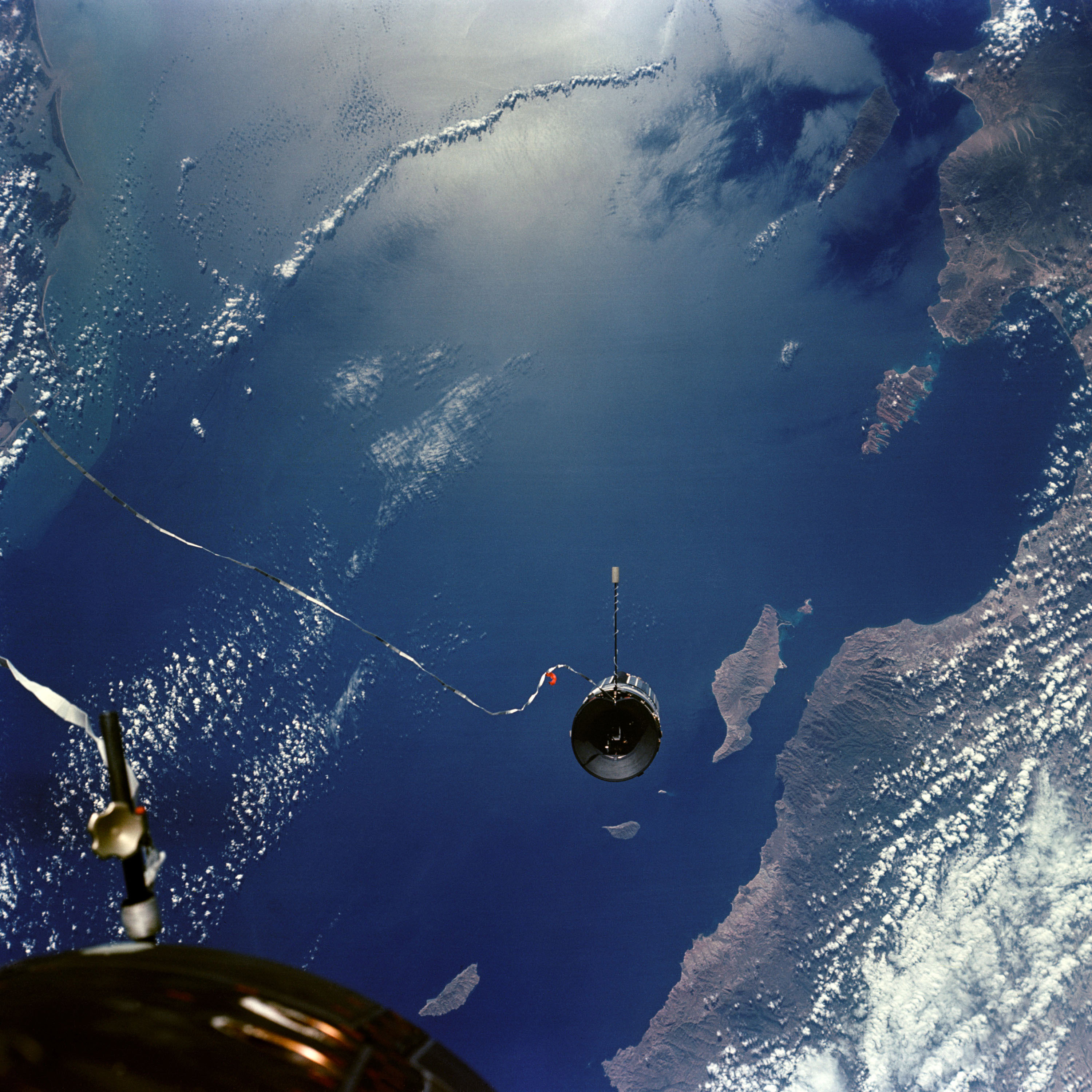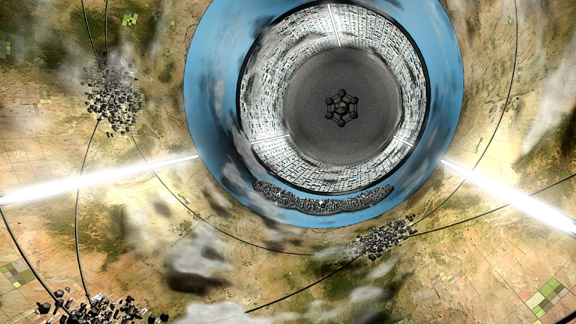|
Island Three
An O'Neill cylinder (also called an O'Neill colony) is a space settlement concept proposed by American physicist Gerard K. O'Neill in his 1976 book '' The High Frontier: Human Colonies in Space''. O'Neill proposed the colonization of space for the 21st century, using materials extracted from the Moon and later from asteroids. An O'Neill cylinder would consist of two counter-rotating cylinders. The cylinders would rotate in opposite directions to cancel any gyroscopic effects that would otherwise make it difficult to keep them aimed toward the Sun. Each would be in diameter and long, connected at each end by a rod via a bearing system. Their rotation would provide artificial gravity. Background While teaching undergraduate physics at Princeton University, O'Neill set his students the task of designing large structures in outer space, with the intent of showing that living in space could be desirable. Several of the designs were able to provide volumes large enough to be sui ... [...More Info...] [...Related Items...] OR: [Wikipedia] [Google] [Baidu] |
Hermann Oberth
Hermann Julius Oberth (; 25 June 1894 – 28 December 1989) was an Austro-Hungarian-born German physicist and engineer. He is considered one of the founding fathers of rocketry and astronautics, along with Robert Esnault-Pelterie, Konstantin Tsiolkovsky, Robert Goddard and Herman Potočnik.During WWII he supported Nazi Germany's ''Aggregat'' rocket program. Early life Oberth was born to a Transylvanian Saxon family in Nagyszeben (Hermannstadt), Austrian-Hungary Empire (today Sibiu in Romania). He was fluent in Romanian language. At the age of 11 years, Oberth's interest in rocketry was set off by the novels of Jules Verne, especially ''From the Earth to the Moon'' and ''Around the Moon''. He was fond of reading them over and over until they were engraved in his memory. As a result, Oberth constructed his first model rocket as a school student at the age of 14. In his youthful experiments, he arrived independently at the concept of the multistage rocket. However, during this ... [...More Info...] [...Related Items...] OR: [Wikipedia] [Google] [Baidu] |
Artificial Gravity
Artificial gravity is the creation of an inertial force that mimics the effects of a gravitational force, usually by rotation. Artificial gravity, or rotational gravity, is thus the appearance of a centrifugal force in a rotating frame of reference (the transmission of centripetal acceleration via normal force in the non-rotating frame of reference), as opposed to the force experienced in linear acceleration, which by the equivalence principle is indistinguishable from gravity. In a more general sense, "artificial gravity" may also refer to the effect of linear acceleration, e.g. by means of a rocket engine. Rotational simulated gravity has been used in simulations to help astronauts train for extreme conditions. Rotational simulated gravity has been proposed as a solution in human spaceflight to the adverse health effects caused by prolonged weightlessness. However, there are no current practical outer space applications of artificial gravity for humans due to concerns ... [...More Info...] [...Related Items...] OR: [Wikipedia] [Google] [Baidu] |
Lunar Base Concept Drawing S78 23252
Lunar most commonly means "of or relating to the Moon". Lunar may also refer to: Arts and entertainment * ''Lunar'' (series), a series of video games * "Lunar" (song), by David Guetta * "Lunar", a song by Priestess from the 2009 album ''Prior to the Fire'' * Lunars, a fictional race in the series ''The Lunar Chronicles'' by Marissa Meyer Other uses * Lunar Magic, Super Mario World level editor * Lunar Design, or LUNAR, a San Francisco-based design consultancy * Hasselblad Lunar, a digital camera * Lunar, a brandname of Ethinylestradiol/cyproterone acetate, a birth control pill * Lunar C (Jake Brook, born 1990), English rapper See also * * * Lunar calendar, based upon the monthly cycles of the Moon's phase ** Lunar day, in such calendars ** Lunar month, in such calendars * Moon (other) * Luna (other) Luna commonly refers to: * Earth's Moon, named "Luna" in Latin * Luna (goddess), the ancient Roman personification of the Moon Luna may also refer to: Places ... [...More Info...] [...Related Items...] OR: [Wikipedia] [Google] [Baidu] |
Mass Driver
A mass driver or electromagnetic catapult is a proposed method of non-rocket spacelaunch which would use a linear motor to Acceleration, accelerate and catapult Payload (air and space craft), payloads up to high speeds. Existing and contemplated mass drivers use coils of wire energized by electricity to make electromagnets, though a rotary mass driver has also been proposed. Sequential firing of a row of electromagnets accelerates the payload along a path. After leaving the path, the payload continues to move due to momentum. Although any device used to propel a Ballistics, ballistic payload is technically a mass driver, in this context a mass driver is essentially a coilgun that magnetically accelerates a package consisting of a magnetizable holder containing a payload. Once the payload has been accelerated, the two separate, and the holder is slowed and recycled for another payload. Mass drivers can be used to propel spacecraft in three different ways: A large, ground-based mas ... [...More Info...] [...Related Items...] OR: [Wikipedia] [Google] [Baidu] |
Agricultural
Agriculture or farming is the practice of cultivating Plant, plants and livestock. Agriculture was the key development in the rise of Sedentism, sedentary human civilization, whereby farming of Domestication, domesticated species created food Economic surplus, surpluses that enabled people to live in cities. The history of agriculture began thousands of years ago. After gathering wild grains beginning at least 105,000 years ago, nascent farmers began to plant them around 11,500 years ago. Sheep, goats, pigs and cattle were domesticated over 10,000 years ago. Plants were independently cultivated in at least 11 regions of the world. Industrial agriculture based on large-scale monoculture in the twentieth century came to dominate agricultural output, though about 2 billion people still depended on subsistence agriculture. The major agricultural products can be broadly grouped into Food, foods, Fiber, fibers, fuels, and raw materials (such as Natural rubber, rubber). Food clas ... [...More Info...] [...Related Items...] OR: [Wikipedia] [Google] [Baidu] |
National Space Society
The National Space Society (NSS) is an American international nonprofit 501(c)(3) educational and scientific organization specializing in space advocacy. It is a member of the Independent Charities of America and an annual participant in the Combined Federal Campaign. The society's vision is: "People living and working in thriving communities beyond the Earth, and the use of the vast resources of space for the dramatic betterment of humanity." The society supports human spaceflight and robotic spaceflight, by both the public (e.g., NASA, Russian Federal Space Agency and Japan Aerospace Exploration Agency) and private sector (e.g., SpaceX, Blue Origin, Virgin Galactic, etc.) organizations. History The society was established in the United States on March 28, 1987, by the merger of the National Space Institute, founded in 1974 by Dr. Wernher von Braun, and the L5 Society, founded in 1975 based on the concepts of Dr. Gerard K. O'Neill. The society has an elected volunteer Board ... [...More Info...] [...Related Items...] OR: [Wikipedia] [Google] [Baidu] |
Diameter
In geometry, a diameter of a circle is any straight line segment that passes through the center of the circle and whose endpoints lie on the circle. It can also be defined as the longest chord of the circle. Both definitions are also valid for the diameter of a sphere. In more modern usage, the length d of a diameter is also called the diameter. In this sense one speaks of diameter rather than diameter (which refers to the line segment itself), because all diameters of a circle or sphere have the same length, this being twice the radius r. :d = 2r \qquad\text\qquad r = \frac. For a convex shape in the plane, the diameter is defined to be the largest distance that can be formed between two opposite parallel lines tangent to its boundary, and the is often defined to be the smallest such distance. Both quantities can be calculated efficiently using rotating calipers. For a curve of constant width such as the Reuleaux triangle, the width and diameter are the same because all ... [...More Info...] [...Related Items...] OR: [Wikipedia] [Google] [Baidu] |
Cylinder (geometry)
A cylinder (from ) has traditionally been a three-dimensional solid, one of the most basic of curvilinear geometric shapes. In elementary geometry, it is considered a prism with a circle as its base. A cylinder may also be defined as an infinite curvilinear surface in various modern branches of geometry and topology. The shift in the basic meaning—solid versus surface (as in ball and sphere)—has created some ambiguity with terminology. The two concepts may be distinguished by referring to solid cylinders and cylindrical surfaces. In the literature the unadorned term cylinder could refer to either of these or to an even more specialized object, the ''right circular cylinder''. Types The definitions and results in this section are taken from the 1913 text ''Plane and Solid Geometry'' by George Wentworth and David Eugene Smith . A ' is a surface consisting of all the points on all the lines which are parallel to a given line and which pass through a fixed plane curve in a pla ... [...More Info...] [...Related Items...] OR: [Wikipedia] [Google] [Baidu] |
Stanford Torus
The Stanford torus is a proposed NASA design for a space habitat capable of housing 10,000 to 140,000 permanent residents. The Stanford torus was proposed during the 1975 NASA Summer Study, conducted at Stanford University, with the purpose of exploring and speculating on designs for future space colonies (Gerard O'Neill later proposed his Island One or Bernal sphere as an alternative to the torus). "Stanford torus" refers only to this particular version of the design, as the concept of a ring-shaped rotating space station was previously proposed by Wernher von Braun and Herman Potočnik. It consists of a torus, or doughnut-shaped ring, that is 1.8 km in diameter (for the proposed 10,000 person habitat described in the 1975 Summer Study) and rotates once per minute to provide between 0.9g and 1.0g of artificial gravity on the inside of the outer ring via centrifugal force. Sunlight is provided to the interior of the torus by a system of mirrors, including a large no ... [...More Info...] [...Related Items...] OR: [Wikipedia] [Google] [Baidu] |
Bernal Sphere
A Bernal sphere is a type of space habitat intended as a long-term home for permanent residents, first proposed in 1929 by John Desmond Bernal. Bernal's original proposal described a hollow non-rotating spherical shell in diameter, with a target population of 20,000 to 30,000 people. The Bernal sphere would be filled with air. O'Neill versions Island One In a series of studies held at Stanford University in 1975 and 1976 with the purpose of speculating on designs for future space colonies, Dr. Gerard K. O'Neill proposed ''Island One,'' a modified Bernal sphere with a diameter of only rotating at 1.9 RPM to produce a full Earth artificial gravity at the sphere's equator. The result would be an interior landscape that would resemble a large valley running all the way around the equator of the sphere. ''Island One'' would be capable of providing living and recreation space for a population of approximately 10,000 people, with a "Crystal Palace" habitat used for agriculture. Sunl ... [...More Info...] [...Related Items...] OR: [Wikipedia] [Google] [Baidu] |
Rendezvous With Rama
''Rendezvous with Rama'' is a science fiction novel by British writer Arthur C. Clarke first published in 1973. Set in the 2130s, the story involves a cylindrical alien starship that enters the Solar System. The story is told from the point of view of a group of human explorers who intercept the ship in an attempt to unlock its mysteries. The novel won both the Hugo and Nebula awards upon its release, and is regarded as one of the cornerstones in Clarke's bibliography. The concept was later extended with several sequels, written by Clarke and Gentry Lee. Plot After an asteroid falls in Northeast Italy on 11 September 2077, creating a major disaster, the government of Earth sets up the Spaceguard system as an early warning of arrivals from deep space. The "Rama" of the title is an alien starship weighing at least ten trillion tons, initially mistaken for an asteroid categorised as "31/439". It is detected by astronomers in the year 2131 while it is still outside the orb ... [...More Info...] [...Related Items...] OR: [Wikipedia] [Google] [Baidu] |





